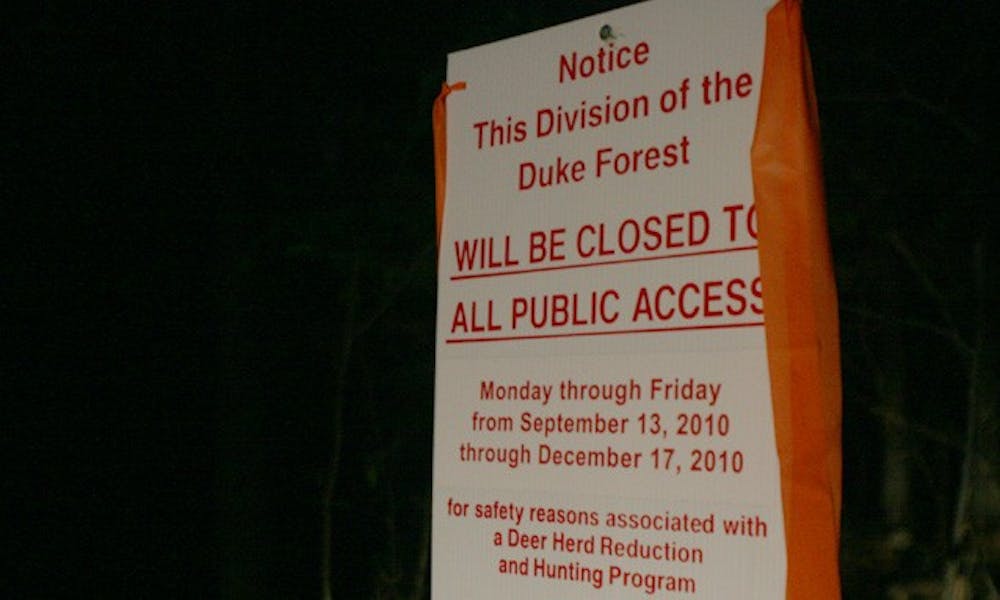During the past several years, it has become clear that the increasing deer population in Duke Forest is problematic.
This is the third year that Duke Forest is participating in the North Carolina Wildlife Resources Commission’s Deer Management Assistance Program. The program, which takes place each fall, selects two private professional hunting groups to hunt deer in designated areas of the forest.
“The deer have eaten everything green,” said Marissa Hartzler, program director of Duke Forest. “It’s affecting the biodiversity of the forest.”
Although there have been no reported cases on Duke’s campus, the overpopulation of deer has also resulted in an increased number of tick-borne diseases as well as deer-related car accidents throughout North Carolina, Hartzler said.
“In the winter, there’s nothing for the deer to eat but our pine seedlings, which can slow down pine tree regrowth and [pine wood] is where we get a lot of our operating budget,” she added.
Population research conducted by Duke Forest in 2008 found that in some areas, there were 80 deer in a single square mile even though the recommended density is 15 to 20 deer per square mile.
This year, NCWRC has given the hunting groups permission to kill a maximum of 200 deer between its start date of Sept. 13 through Dec. 17. During this time, three sections of the forest will be closed to the public on weekdays.
Although the program limits the forest’s recreational use, it has not affected University or outside research in the forest.
Forest staff members have tried to minimize disruption while making sure those conducting research are safe, providing them with special parking permits and easy-to-see vests. The staff is also aware of the hunters’ and researchers’ locations at all times so both parties can work safely and simultaneously, Hartzler said.
“Because the primary mission of the forest is research and teaching, the forest staff has been wonderful in continuing the research in the forest,” said Jeffrey Pippen, an instructor for Duke’s Program in Ecology.
Pippen, whose research on forest understory was affected by the deer overpopulation, said he anticipates future benefits for his work from the program. However, he has not yet seen any immediate improvements.
The program is also assisting in a related research project conducted by the North Carolina Department of Environment and Natural Resource’s Environmental Health Division.
The Tick Attachment Project, which began February 2009, asks for the submission of ticks across the state to raise awareness of tick-borne illnesses in North Carolina, according to Dr. Barry Engber, a medical entomologist for NCDENR’s Pest Management section.
The increased deer population causes a rise in ticks, bringing many diseases to North Carolina such as Rocky Mountain Spotted Fever, Ehrlichia and Lyme Disease, he said.
The professional hunting groups collect the ticks from the deer and send them to NCDENR. But the tick population remains prevalent in the forest.
“There has not been enough reduction yet to make a difference that would be noticed,” Engber said. “You pretty much have to get the deer population down to almost nothing to control the [tick] population.”
Duke Forest’s participation in the Deer Management Assistance Program has stirred some controversy. The main complaint comes from people who use the park for recreation, said Hartzler.
“The base complaint is that we have to close the forest for liability concerns... that they cannot go to [those areas] of the forest during the week,” she said. “Our biggest concern is safety.”
Although several areas of the forest have shown significant improvements, this will not be the program’s last year in the forest.
“For so long, nothing was done,” Hartzler said. “We’re hoping that over time we will make a lot of progress, and then we won’t have to have such an intensive program.”
Get The Chronicle straight to your inbox
Signup for our weekly newsletter. Cancel at any time.

